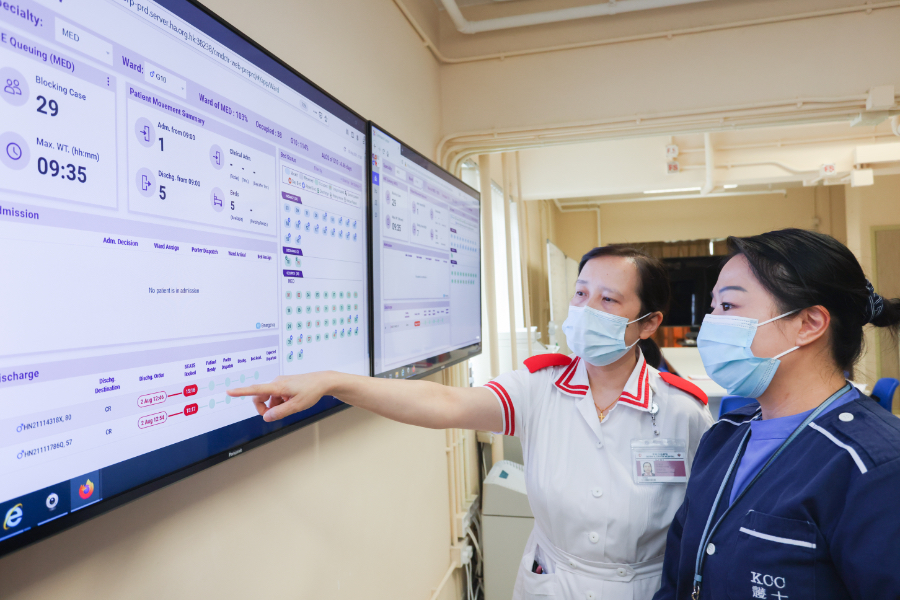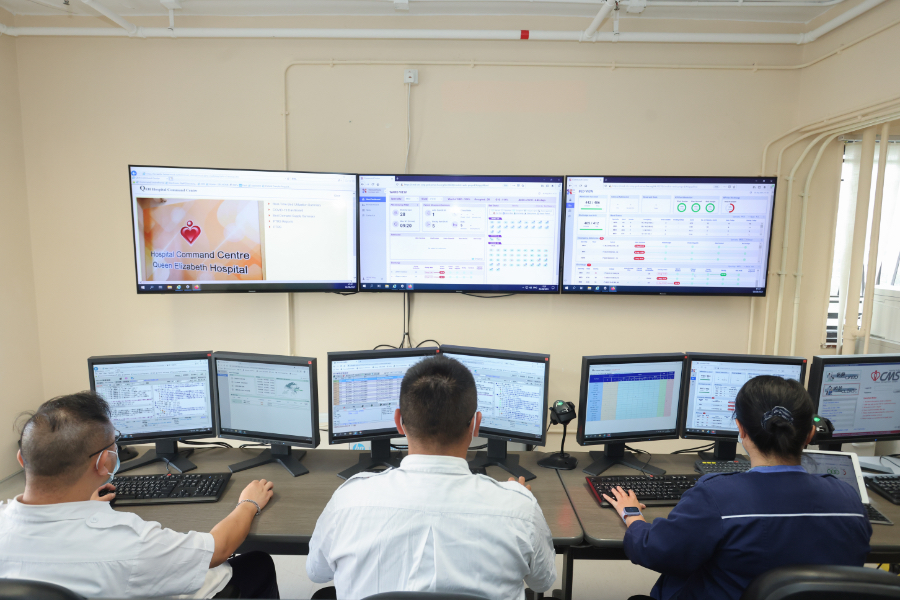New intelligent Command Centre breaks through bottlenecks

With constant flow of patients seeking treatment, the Queen Elizabeth
Hospital (QEH) is one of the busiest hospitals in Hong Kong. “The Accident and Emergency
Department (A&E) was often packed with patients waiting for admission. Sometimes there
were 80 or even a hundred people waiting at a time,” Kowloon Central Cluster General
Manager (Nursing) Li Wah-chun says. “Even not at the time of winter
surge, there is a surge everyday right here.” Overcrowding at A&E became a pressing
issue especially during the COVID-19 pandemic as it would increase the risk of
cross-infection. QEH colleagues tried to resolve the problem for a long time and
realised that inter-departmental communication was the key as patient treatment journey
involved different departments. As such, they adopted advanced technology to connect
different teams for better coordination in order to reduce patient waiting times.
Maximising our capacity for care
Opportunity finally arose at the beginning of the COVID-19 as new
isolation wards were added to the QEH. The hospital pioneered the use of an electronic
dashboard to replace manual records of allocation of beds and wards for patients, which
gradually formed the prototype of the new QEH Command Centre. Today, there are three
large screens hanging on a wall and more than 10 computer screens installed at the
Command Centre. Colleagues are closely monitoring the status of each patient to speed up
the discharge process.
The QEH Command Centre was piloted in April this year with three key functions: clinical management, bed capacity management, and resources management with a view to keeping track of the entire patient treatment journey from arrival at A&E to admission, transfer to rehabilitation hospital or discharge. The system integrates figures of beds and wards to give a full picture of the overall ward utilisation including the bed occupancy rate, the average length of stay, daily admission and discharge statistics which helps the team understand the discharge process and the status of the patients, as well as shorten waiting times for admission.
With the help of technology, the reason of access block could be identified easily. For example, healthcare workers can promptly follow up on a case who has waited to be discharged for a long time. After the launch of the pilot programme, the number of patients waiting in A&E for admission once dropped to single digits. “Our colleagues describe it as a miracle and we are all thrilled with the outcome,” Li says with a smile.
The QEH Command Centre was piloted in April this year with three key functions: clinical management, bed capacity management, and resources management with a view to keeping track of the entire patient treatment journey from arrival at A&E to admission, transfer to rehabilitation hospital or discharge. The system integrates figures of beds and wards to give a full picture of the overall ward utilisation including the bed occupancy rate, the average length of stay, daily admission and discharge statistics which helps the team understand the discharge process and the status of the patients, as well as shorten waiting times for admission.
With the help of technology, the reason of access block could be identified easily. For example, healthcare workers can promptly follow up on a case who has waited to be discharged for a long time. After the launch of the pilot programme, the number of patients waiting in A&E for admission once dropped to single digits. “Our colleagues describe it as a miracle and we are all thrilled with the outcome,” Li says with a smile.
Shaping a smarter healthcare future
Apart from improving the admission and discharge process, patient
transfer arrangements have been enhanced. Advance Practice Nurse (Pre-Discharge
Services) Elaine Wong explains that ward staff previously have to call
different departments including the rehabilitation hospital to check availability of bed
and also the Non-Emergency Ambulance Transfer Service (NEATS) to arrange a patient
transfer. It can be chaotic if the patient transfer is arranged during mealtime or there
is unexpected situation happened in the ward such as a patient left his/her bed. “Now
nurses can check the number of beds available in rehabilitation hospitals through the
dashboard, speeding up the discharge arrangements and expediting the turnover of
hospital beds,” Elaine says. “Meanwhile, our NEATS colleagues are aware of the number of
patients who are ready to be transferred and hence timely transportation will be
arranged accordingly. With the help of technology to analyse data, we can identify the
bottlenecks in advance and tackle them. There are fewer patient complaints, and it is
definitely a win-win-win situation.”
Looking ahead, the team will explore the possibility of linking the eVital system to the dashboard, and make use of artificial intelligence to estimate patients’ risk of deterioration and to predict their length of stay. The service of Command Centre will also be extended to the specialties of surgery, orthopedics and neurosurgery, which usually cause access block in A&E. Li hopes that by the time the new acute hospital in the Kai Tak Development Area commences service, all hospital beds within the cluster could be monitored by the Command Centre with a view to maximising the utilisation of all resources and facilitating the patient flow, hence the vision of smart hospital will be fully realised.
Looking ahead, the team will explore the possibility of linking the eVital system to the dashboard, and make use of artificial intelligence to estimate patients’ risk of deterioration and to predict their length of stay. The service of Command Centre will also be extended to the specialties of surgery, orthopedics and neurosurgery, which usually cause access block in A&E. Li hopes that by the time the new acute hospital in the Kai Tak Development Area commences service, all hospital beds within the cluster could be monitored by the Command Centre with a view to maximising the utilisation of all resources and facilitating the patient flow, hence the vision of smart hospital will be fully realised.

